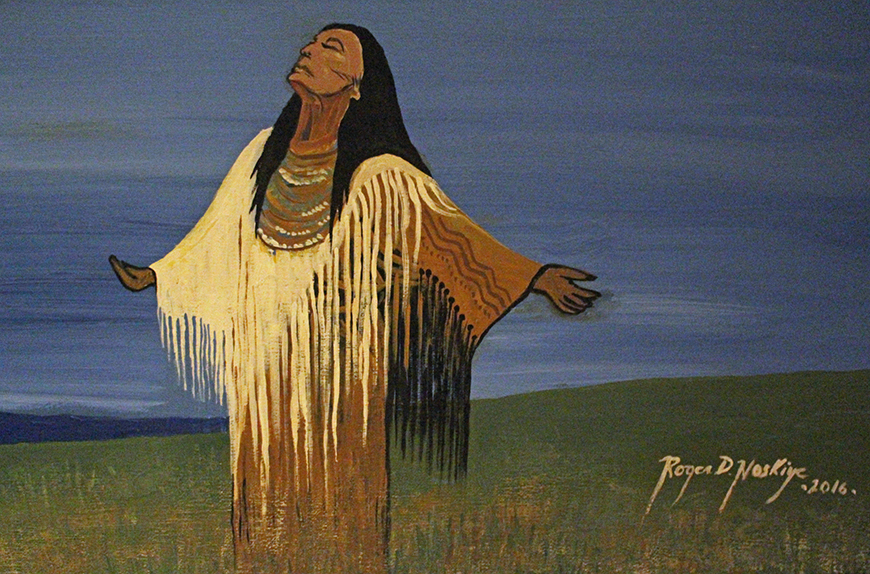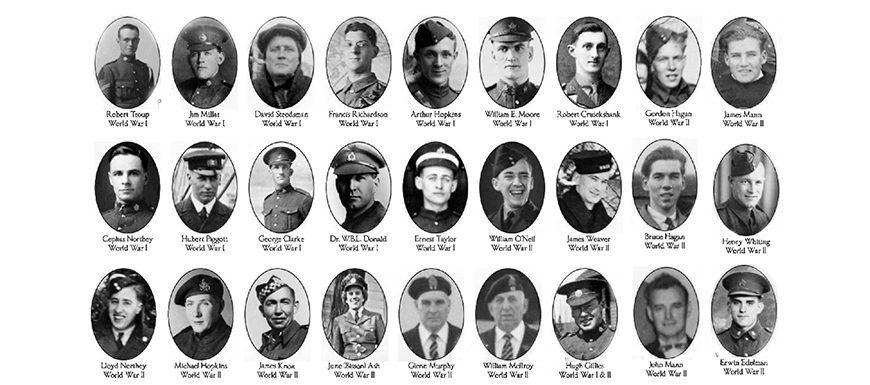This piece is part of an on-going series entitled “Pondering Peace River’s Past,” or “Ponderings,” they’re researched and written by the Peace River Museum Archive and Mackenzie Centre’s researcher Beth Wilkins. Ponderings appears in print in the Peace River Record-Gazette each week.
We Remember
Remembering is not always easy – memories not always pleasant – but memories – remembering is part of living – part of being – Lest We Forget.
Indigenous men and women joined those of other backgrounds to enlist in the various conflicts in which we have been involved – to fight for – a country we call Canada – a land in which we take pride. It would be well for us to remember we have all lost those we hold dear – regardless of racial background – regardless of skin colour – regardless of faith or lack – regardless – a loss is a loss – a life is a life.
It is a time to reflect – regardless – not to be morbid, but rather to be thoughtful – respectful of what others have done for us – have meant to us. Although thoughts may be related to wars and battles – they are not only those fought on foreign lands – often they are the ones fought on home ground – domestic.
We may think of the missing and murdered women and girls – often Indigenous, who have succumbed to the viciousness of how humans treat other humans sometimes as a reaction – frustration to racial background or gender or in many cases – who knows what. We are want to say this viciousness must stop – yes, but how? We don’t always have a viable solution. Thankfully, there are those who have spent much time to find a potential solution – a guidance – a hope.
Every year at this time, our country collectively remembers the men and women who served in the many wars in which we have been involved. This year, it seems appropriate to include in our memories the Indigenous women, who enlisted in our Armed Forces. On the backcover of Our Women in Uniform – a collection of memories from Aboriginal women in the Canadian Women’s Army Corps and Royal Canadian Air Force units in Canada during the Second World War and after the war – “These women deserve to be lauded for their strength, bravery and leadership. In addition to serving our country well, they were also leaders paving the way for women to make different and non-traditional choices in life. They are pioneers whose life stories continue to enrich a new generation – inspiring us to see beyond barriers and follow our dreams.” – Pearl Calahasen, former Minister of Aboriginal Affairs and Northern Development for the Province of Alberta, serving 26 years as the Member of the Legislative Assembly for the Lesser Slave Lake constituency. Born in Grouard, she was the first Métis woman ever elected in Alberta. Pearl earned her B. A. in Education from the University of Alberta and an M. A. from the University of Oregon. She is currently the First Nations, Métis and Inuit Pedagogical Supervisor for Northland School Division No. 61, comprised of 24 schools.

Historian Dr. Olive Dickason also wrote on the backcover of Our Women in Uniform. “The Story of the military role of Canada’s Aboriginal Women is both significant and engaging. This collection of personal histories of Aboriginal Women depicts their role, not only in the military, but in the setting and development of our country and consequently enriches Canadian history.”
Dr. Dickason, a Métis woman born in Winnipeg in 1920, is remembered for her several careers, which included that of a journalist and researcher and writer of Aboriginal history. “She held a deep passion for early Canadian history and her pride and interest in her own Métis heritage are reflected in her works.” She is the author of The Myth of the Savage and the Beginnings of French Colonization in the Americas, The Law of Nations and the New World (co-author) and Canada’s First Nations: A History of Founding Peoples from Earliest Times (1992). From 1985-1992, she was Professor of History at the University of Alberta. She died March 2011. “Dr. Dickason’s contribution about First Nations and Métis history will be profoundly cherished and forever valued.”
Our Women in Uniform features Corporal Bertha Houle, Leading Aircraft Woman Betsy Houle, Private Gladys Irish, Fighter Control Operator Theresa Loyie, Leading Airwoman Marguerite St. Germaine, Sergeant Dorothy Bellerose, Private Mary Cardinal and Private Teresa Dion.
Thousands of Canadian women enlisted eager to serve their country. “In the beginning, it was made abundantly clear they were being accepted only so the men would be free to do the more important jobs that involved active duty in hazardous conditions.” Even though frontline action would not be available to them, they enlisted anyway. Patriotism, chance of a new experience, adventure and travel, or “simply because their friends or family members had already joined” were good enough reasons. “They wanted to be involved.
Though women’s entry into the military may have been taken lightly, before their application was accepted, they had to meet the same physical requirements as the men. “Women had made it in. It was one of the rare times, Aboriginal women, who enlisted, found they did not have to face or overcome racial discrimination; they were accepted as part of the military.”
Bertha Houle from Clear Hills, Alberta, says, “One of the best things about being a part of the services is that I never once felt any sort of discrimination in the Air Force. It did not seem to matter that I was young, Aboriginal or a woman. I believe all enlisted personnel were treated as equals by everyone involved. This was the way it was because we had formed a bond that came about from working closely together as a team and sharing the same beliefs and values about what we were fighting for. Aside from that, everyone was too busy and as every extra hand was needed, there was no time or place for discriminatory practices.”
One thing she noticed – First Nations peoples lost their status when they left the reserves to join. This meant no land or houses when they returned. “I was one of the lucky ones because I had a good counsellor when I was eventually discharged from the RCAF. I was offered a chance to go to university to complete a Physical Education Teaching degree, but I chose to go into hairdressing and the services paid for it.”
For her, the RCAF was a positive experience. “When I left, I took with me a higher degree of education and many practical skills, knowledge and abilities to forge a great life for myself as a private citizen.”
Betsy Houle, Bertha’s sister, also entered the Air Force a year after in October 1942. According to her account in Our Women in Uniform her service experience was as interesting and as rewarding as her sister’s.
For the other Métis women in the book, the Armed Forces proved to be a positive experience and an opportunity to learn and gain self-confidence and realize a pride in serving their country.
From a Veteran’s Affairs Canada account: Edith Anderson, an elementary school nurse, attended New Rochelle School of Nursing in New York State because Canada offered few training opportunities, at that time – 1914 – for the young Six Nations Grand River Reserve woman. Grande River is in the heart of Southern Ontario in the Golden Horseshoe.
She left her school job to join the U. S. Medical Corps in 1917 to tend sick and wounded soldiers in an American military hospital in France. She spent most of her time at the hospital treating soldiers who had been shot or gassed. Occasionally, she was posted to assist at other medical centres. This provided an opportunity to see more of the country, not always the experience she appreciated.
A reporter from her local newspaper – Grand River Sachem – interviewed Edith, age 93 in 1983 regarding her war memories. “We would walk right over where there had been fighting. It was an awful sight – buildings in rubble, trees burnt, spent shells all over the place, whole towns blown up.”
Check out the next issue of the Record-Gazette for the second part of this story.

